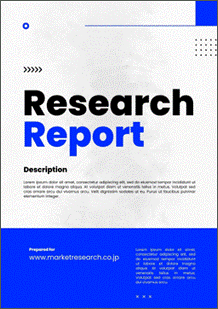 | • レポートコード:B-MOR-08617 • 出版社/出版日:Mordor Intelligence / 2018年5月18日 • レポート形態:英文、PDF、111ページ • 納品方法:Eメール(受注後2営業日) • 産業分類:医療・製薬 |
| Single User(1名様用) | ¥629,000 (USD4,250) | ▷ お問い合わせ |
| Team User(7名様用) | ¥666,000 (USD4,500) | ▷ お問い合わせ |
| Corporate User | ¥1,295,000 (USD8,750) | ▷ お問い合わせ |
• お支払方法:銀行振込(納品後、ご請求書送付)
レポート概要
| 本資料は、ウェアラブル医療機器の世界市場について調べ、ウェアラブル医療機器の世界規模、市場動向、市場環境、製品種類別(ウェアラブル生体信号モニター、ウェアラブル分娩監視装置・産科機器、神経モニタリング機器、ウェアラブル疼痛管理機器、ウェアラブルグルコース・インスリンモニタリング機器、ウェアラブル呼吸療法機器)分析、用途別(スポーツ・フィットネス、遠隔患者モニタリング、在宅医療)分析、デバイス種類別分析、アメリカ市場規模、ヨーロッパ市場規模、アジア市場規模、日本市場規模、中国市場規模、企業の競争環境、関連企業情報などをまとめた調査レポートです。 ・イントロダクション ・エグゼクティブサマリー ・ウェアラブル医療機器の世界市場インサイト ・ウェアラブル医療機器の世界市場環境 ・ウェアラブル医療機器の世界市場動向 ・ウェアラブル医療機器の世界市場規模 ・ウェアラブル医療機器の世界市場規模:製品種類別(ウェアラブル生体信号モニター、ウェアラブル分娩監視装置・産科機器、神経モニタリング機器、ウェアラブル疼痛管理機器、ウェアラブルグルコース・インスリンモニタリング機器、ウェアラブル呼吸療法機器) ・ウェアラブル医療機器の世界市場規模:用途別(スポーツ・フィットネス、遠隔患者モニタリング、在宅医療) ・ウェアラブル医療機器の世界市場規模:デバイス種類別 ・ウェアラブル医療機器の世界市場:地域別市場規模・分析 ・ウェアラブル医療機器の北米市場規模・予測 ・ウェアラブル医療機器のアメリカ市場規模・予測 ・ウェアラブル医療機器のヨーロッパ市場規模・予測 ・ウェアラブル医療機器のアジア市場規模・予測 ・ウェアラブル医療機器の日本市場規模・予測 ・ウェアラブル医療機器の中国市場規模・予測 ・ウェアラブル医療機器のインド市場規模・予測 ・ウェアラブル医療機器の韓国市場規模・予測 ・関連企業情報・競争状況 |
A wearable medical device is used to track or monitor parameters, such as heart rate, blood glucose level, and blood pressure. The range of devices includes watches, bands, clothing, and accessories. The global wearable medical devices market is expected to register a CAGR of about 19% during 2018-2023 (the forecast period).
Increasing Technological Advancements and Innovations
A medical wearable devices can improve the lifestyles of patients as well as the general population. Currently, these devices are gaining an immense popularity, due to improved technologies that are being introduced every day by key market players. These devices can help consumers manage their health, along with taking care of healthcare costs. Over the last 2-3 years, the healthcare wearable devices market has witnessed a boost, with giant electronic companies competing with the young and crowd-funded startups. The focus is shifting from fitness trackers and apps to wearable medical devices that are designed to collect specific healthcare data.
Increasing per-capita income in developing countries and ease-of-use and interpretation of medical devices are some of the other factors contributing to the market growth.
High Cost of Devices
Wearable medical devices that are available at present have been designed keeping in mind an elite crowd. The cost of wearable devices is one of the major challenges for the growth prospects of the market. Most manufacturers launch their products in the premium product category. For instance, the average selling price (ASP) of a smart wearable is around USD 350-380, depending on the application. The ASP of a healthcare wearable device is around USD 720-750 and for fitness and lifestyle product, it is between USD 280-350.
Additionally, unfavorable reimbursement issues and a lack of awareness are a few other factor restraining the wearable medical devices market growth.
North America to Dominate the Market
The global wearable medical devices market has been segmented on the basis of product type, application, device type, and geography. By geography, it is further segmented into North America, Europe, Asia-Pacific, the Middle East & Africa, and South America.
Owing to the factors, like rising number of incidences of chronic diseases, the need to curb healthcare expenditure, and the growing demand for home-based and remote monitoring devices, North America is dominating the market.
Key Developments in the Market
• February 2018 – Fitbit acquired, a small Boston-based software startup called, Twine Health.
Major Players: FITBIT, XIAOMI INC., APPLE, GARMIN LTD, SAMSUNG, LIFESENSE, LIFEWATCH AG, PHILIPS ELECTRONICS, POLAR ELECTRO, SOTERA WIRELESS, and ACTELION PHARMACEUTICALS, among others..
Reasons to Purchase The Report
• Market analysis for the Global Wearable Medical Devices Market, with region-specific assessments and competition analysis on the global and regional scale.
• Various perspectives of the industry, with the help of Porter’s five forces analysis
• The treatment type that is expected to dominate the market
• Region that is expected to witness the fastest growth rate during the forecast period
• The latest developments, market shares, and strategies that are employed by the major market players
• 3 months analyst support, along with the Market Estimate sheet (in Excel)
Customization of the Report
• This report can be customized to meet your requirements. Please connect with our representative, who will ensure you get a report that suits your needs.
レポート目次1. Introduction
1.1 Market Definition
2. Research Methodology
3. Executive Summary
4. Key Inferences
5. Market Overview
5.1 Current Market Scenario
5.2 Porter’s Five Forces Analysis
5.2.1 Bargaining Power of Suppliers
5.2.2 Bargaining Power of Consumers
5.2.3 Threat of New Entrants
5.2.4 Threat of Substitute Product and Services
5.2.5 Competitive Rivalry Within the Industry
6. Drivers, Restraints, Opportunities, and Challenges Analysis (DROC)
6.1 Market Drivers
6.1.1 Increasing Technological Advancements and Innovations
6.1.2 Increasing per-capita Income in developing countries
6.1.3 Ease-of-use and Interpretation of Medical Devices
6.2 Market Restraints
6.2.1 High Cost of Wearable Devices
6.2.2 Unfavorable Reimbursement Issues
6.2.3 Current Lack of Awareness in Some Regions
6.3 Opportunities
6.4 Key Challenges
6.4.1 Lack of Data Privacy and Safety
7. Market Segmentation
7.1 By Product Type
7.1.1 Wearable Vital Sign Monitors
7.1.1.1 Wearable Heart Rate Monitors
7.1.1.2 Wearable Activity Monitors
7.1.1.3 Wearable Electrocardiographs
7.1.1.4 Wearable Sleep Monitors
7.1.2 Wearable Fetal Monitors and Obstetric Devices
7.1.3 Neuro-monitoring Devices
7.1.3.1 Electroencephalographs
7.1.3.2 Electromyographs
7.1.4 Pain Management Wearable Medical Devices
7.1.5 Glucose/Insulin Monitoring Wearable Devices
7.1.6 Respiratory Therapy Wearable Devices
7.2 By Application
7.2.1 Sports and Fitness
7.2.2 Remote Patient Monitoring
7.2.3 Home Healthcare
7.3 By Device Type
7.3.1 Watch
7.3.2 Wristband
7.3.3 Clothing
7.3.4 Ear Wear
7.3.5 Others
7.4 By Geography
7.4.1 North America
7.4.1.1 United States
7.4.1.2 Canada
7.4.1.3 Mexico
7.4.2 Europe
7.4.2.1 France
7.4.2.2 United Kingdom
7.4.2.3 Germany
7.4.2.4 Italy
7.4.2.5 Spain
7.4.2.6 Rest of Europe
7.4.3 Asia-Pacific
7.4.3.1 India
7.4.3.2 China
7.4.3.3 Japan
7.4.3.4 Australia
7.4.3.5 South Korea
7.4.3.6 Rest of Asia-Pacific
7.4.4 Middle East & Africa
7.4.4.1 GCC
7.4.4.2 South Africa
7.4.4.3 Rest of Middle East & Africa
7.4.5 South America
7.4.5.1 Brazil
7.4.5.2 Argentina
7.4.5.3 Rest of South America
8. Competitive Landscape
8.1 Mergers and Acquisition Analysis
8.2 Agreements, Collaborations, and Partnerships
8.3 New Products Launches
9. Key Players
9.1 Actelion Pharmaceuticals
9.2 Apple
9.3 Fitbit
9.4 Lifesense
9.5 LifeWatch AG
9.6 Philips Electronics
9.7 Samsung
9.8 Sotera Wireless
9.9 Xiaomi Inc.
9.10 Others
10. Future of the Market